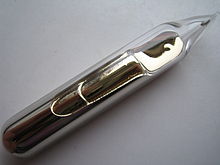
Back Sesium Afrikaans ሴሲየም Amharic Cesio AN सीजियम ANP سيزيوم Arabic سيزيوم ARY سيزيوم ARZ Cesiu AST Sezium Azerbaijani Цезий Bashkir
 | ||||||||||||||||||||||||||||||||||||||
| Caesium | ||||||||||||||||||||||||||||||||||||||
|---|---|---|---|---|---|---|---|---|---|---|---|---|---|---|---|---|---|---|---|---|---|---|---|---|---|---|---|---|---|---|---|---|---|---|---|---|---|---|
| Pronunciation | /ˈsiːziəm/ | |||||||||||||||||||||||||||||||||||||
| Alternative name | cesium (US, informal) | |||||||||||||||||||||||||||||||||||||
| Appearance | pale gold | |||||||||||||||||||||||||||||||||||||
| Standard atomic weight Ar°(Cs) | ||||||||||||||||||||||||||||||||||||||
| 132.90545196(6)[1] | ||||||||||||||||||||||||||||||||||||||
| Caesium in the periodic table | ||||||||||||||||||||||||||||||||||||||
| ||||||||||||||||||||||||||||||||||||||
| Group | group 1: hydrogen and alkali metals | |||||||||||||||||||||||||||||||||||||
| Period | period 6 | |||||||||||||||||||||||||||||||||||||
| Block | s-block | |||||||||||||||||||||||||||||||||||||
| Electron configuration | [Xe] 6s1 | |||||||||||||||||||||||||||||||||||||
| Electrons per shell | 2, 8, 18, 18, 8, 1 | |||||||||||||||||||||||||||||||||||||
| Physical properties | ||||||||||||||||||||||||||||||||||||||
| Phase at STP | solid | |||||||||||||||||||||||||||||||||||||
| Melting point | 301.7 K (28.5 °C, 83.3 °F) | |||||||||||||||||||||||||||||||||||||
| Boiling point | 944 K (671 °C, 1240 °F) | |||||||||||||||||||||||||||||||||||||
| Density (near r.t.) | 1.93 g/cm3 | |||||||||||||||||||||||||||||||||||||
| when liquid (at m.p.) | 1.843 g/cm3 | |||||||||||||||||||||||||||||||||||||
| Critical point | 1938 K, 9.4 MPa[2] | |||||||||||||||||||||||||||||||||||||
| Heat of fusion | 2.09 kJ/mol | |||||||||||||||||||||||||||||||||||||
| Heat of vaporization | 63.9 kJ/mol | |||||||||||||||||||||||||||||||||||||
| Molar heat capacity | 32.210 J/(mol·K) | |||||||||||||||||||||||||||||||||||||
Vapor pressure
| ||||||||||||||||||||||||||||||||||||||
| Atomic properties | ||||||||||||||||||||||||||||||||||||||
| Oxidation states | −1, +1[3] (a strongly basic oxide) | |||||||||||||||||||||||||||||||||||||
| Electronegativity | Pauling scale: 0.79 | |||||||||||||||||||||||||||||||||||||
| Ionization energies |
| |||||||||||||||||||||||||||||||||||||
| Atomic radius | empirical: 265 pm | |||||||||||||||||||||||||||||||||||||
| Covalent radius | 244±11 pm | |||||||||||||||||||||||||||||||||||||
| Van der Waals radius | 343 pm | |||||||||||||||||||||||||||||||||||||
| Other properties | ||||||||||||||||||||||||||||||||||||||
| Natural occurrence | primordial | |||||||||||||||||||||||||||||||||||||
| Crystal structure | body-centered cubic (bcc) | |||||||||||||||||||||||||||||||||||||
| Thermal expansion | 97 µm/(m⋅K) (at 25 °C) | |||||||||||||||||||||||||||||||||||||
| Thermal conductivity | 35.9 W/(m⋅K) | |||||||||||||||||||||||||||||||||||||
| Electrical resistivity | 205 nΩ⋅m (at 20 °C) | |||||||||||||||||||||||||||||||||||||
| Magnetic ordering | paramagnetic[4] | |||||||||||||||||||||||||||||||||||||
| Young's modulus | 1.7 GPa | |||||||||||||||||||||||||||||||||||||
| Bulk modulus | 1.6 GPa | |||||||||||||||||||||||||||||||||||||
| Mohs hardness | 0.2 | |||||||||||||||||||||||||||||||||||||
| Brinell hardness | 0.14 MPa | |||||||||||||||||||||||||||||||||||||
| CAS Number | 7440-46-2 | |||||||||||||||||||||||||||||||||||||
| History | ||||||||||||||||||||||||||||||||||||||
| Naming | from Latin caesius, sky blue, for its spectral colours | |||||||||||||||||||||||||||||||||||||
| Discovery | Robert Bunsen and Gustav Kirchhoff (1860) | |||||||||||||||||||||||||||||||||||||
| First isolation | Carl Setterberg (1882) | |||||||||||||||||||||||||||||||||||||
| Isotopes of caesium | ||||||||||||||||||||||||||||||||||||||
| ||||||||||||||||||||||||||||||||||||||
Preview warning: unknown parameter "electron configuration"
Preview warning: unknown parameter "period"
Preview warning: unknown parameter "block"
Preview warning: unknown parameter "isotopes comment"
Preview warning: unknown parameter "oxidation states"
Preview warning: unknown parameter "isotopes"
Preview warning: unknown parameter "group"
Preview warning: unknown parameter "category"
Preview warning: unknown parameter "category comment"
Preview warning: unknown parameter "oxidation states comment"
Caesium (or cesium) is the chemical element with the atomic number 55 on the periodic table. Its symbol is Cs.
Caesium is an alkali metal. Its melting point is low (28 °C). It is extremely reactive. Because of its high reactivity, it is a dangerous chemical. It may set itself on fire (ignite) in air. It explodes on contact with water. It reacts more violently than the other alkali metals with water. Because of this, caesium is stored in mineral oil.[7]
Caesium is a rare element. Since there is little caesium on the Earth, it is rather expensive. The human body does not need caesium. In large amounts, its chemical compounds are mildly poisonous because it is close to potassium, which the body does need.
- ↑ "Standard Atomic Weights: Caesium". CIAAW. 2013.
- ↑ Haynes, William M., ed. (2011). CRC Handbook of Chemistry and Physics (92nd ed.). Boca Raton, FL: CRC Press. p. 4.121. ISBN 1439855110.
- ↑ 3.0 3.1 Dye, J. L. (1979). "Compounds of Alkali Metal Anions". Angewandte Chemie International Edition. 18 (8): 587–598. doi:10.1002/anie.197905871.
- ↑ "Magnetic susceptibility of the elements and inorganic compounds". Handbook of Chemistry and Physics (PDF) (87th ed.). CRC press. ISBN 0-8493-0487-3. Retrieved 2010-09-26.
- ↑ Kondev, F. G.; Wang, M.; Huang, W. J.; Naimi, S.; Audi, G. (2021). "The NUBASE2020 evaluation of nuclear properties" (PDF). Chinese Physics C. 45 (3): 030001. doi:10.1088/1674-1137/abddae.
- ↑ 6.0 6.1 "NIST Radionuclide Half-Life Measurements". NIST. Retrieved 2011-03-13. Cite error: Invalid
<ref>tag; name "isotope" defined multiple times with different content - ↑ William C. Butterman et al 2004. "Mineral Commodity Profile: Cesium" (PDF). United States Geological Survey. Retrieved 2009-12-27.

